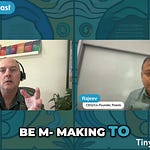Listen now on YouTube | Spotify | Apple Podcasts
The 11-Month AI Validation Trap That's Killing Enterprise Projects
Thomas Been from Domino Data Lab explains why governance accelerates AI deployment by 70% and the validation trap that kills most enterprise projects
Listen now on YouTube | Spotify | Apple Podcasts
The Data Faces Podcast with Thomas Been, CMO at Domino Data Lab
Thomas Been has heard this complaint from enterprise customers more times than he can count. "What's the point of creating a model in three months, when it takes something like 11 months to validate it?"
The frustrated executive was from a life sciences company. His data science team could build AI models quickly but getting them approved and deployed took nearly a year.[1]
Thomas, Chief Marketing Officer at Domino Data Lab, sees this pattern over and over. Organizations can rapidly prototype but get stuck in what he calls "the middle of the river," where they’re caught between outdated governance processes and the need to move fast with AI.
Companies succeeding with AI have solved the validation trap through what Thomas calls "policy-driven AI." They've shortened deployment cycles by 70% by embedding governance into project workflows rather than treating it as a final checkpoint.
About Thomas Been
Thomas brings a unique perspective to enterprise AI challenges. He started studying physics because he "liked to understand how stuff works." That curiosity led him through various roles, including technical, pre-sales, sales, and eventually, marketing leadership. At Domino, he leads marketing for an enterprise AI platform used by the most highly regulated companies in the world, organizations that enable drug discovery, keep financial products safe, and support defense applications that protect countries.
His career progression mirrors the evolution he advocates for AI adoption. Rather than disrupting everything, successful enterprises build on existing capabilities while adapting to new technologies. "Revolution is a term that, even though I'm French, mathematically, revolution brings you back exactly where you started. So evolution is way more interesting."
People, processes, and technology must work as one system
Most AI failures aren't technology failures but rather, they’re alignment failures.
Thomas puts it directly when discussing what separates successful AI projects from the struggling majority. "I'm always tempted to go back to the tried and true people, processes, and technology, but there's an element to it...it's the ability to align all of them."
The silo problem
Consider that life sciences customer again. Their organization had brilliant data scientists scattered across different business units. Each group was essentially "reinventing the wheel" with every project, building similar capabilities from scratch because they couldn't see or weren’t aware of what others had already created.
"It’s mind-blowing how many times we still talk to prospects" in 2025 who are facing this same issue, Thomas notes. Organizations create "pockets of skills" instead of connected teams that learn from one another.
Rather than reorganizing everyone under one department, teams need to work together and share knowledge even when distributed across the company. When a claims processing team can adapt templates from a fraud detection project, both move faster.
From artisanal to industrialized
Data science traditionally operated more like craft work than engineering. Individual contributors developed methods and processes that they kept to themselves. Projects followed unique paths. Success depended heavily on who was assigned to what.
One CIO described this challenge directly to Thomas after successfully standardizing development practices across engineering teams. "I want to apply the same philosophy," the CIO said. "How do I standardize data science to get predictable outputs?”
Data science requires constant iteration though. Teams constantly refine and retrain models, improving efficiency by small percentages each cycle. "If you can iterate very quickly, you're gold, because the model efficiency is going to grow like crazy," Thomas explains.
Development and deployment processes need to support rapid experimentation while maintaining quality standards. Teams need frameworks for identifying expected value upfront rather than building first and hoping for business impact later.
Culture enables everything else
When people, processes, and technology align properly, culture emerges naturally. Thomas describes what happens when the pieces click. "You can inspire...people can work together...you have enough repeatability, and you can get them to be creative."
"It's not the fact that one of them is the issue, but it's the ability to align all of them and the ability to help at each level... Culture sits on top of it, when you have these, then I think you can inspire. You can create a culture."
— Thomas Been, CMO, Domino Data Lab
Successful AI organizations achieve what Thomas calls the "best of both worlds," where teams can pursue experimentation and innovation while delivering consistent business value. This culture attracts top talent because people want environments where they can be both creative and effective.
Composition beats silver bullets
Companies create a false choice when thinking about AI. Some say "AI is Gen AI." Others insist "we're doing data science, we're not doing AI."
Both miss the point entirely.
The spectrum strategy
Thomas sees this "shortcut" thinking constantly. "AI does not equal Gen AI. Gen AI is very fascinating...but it's the composition that's going to matter."
Most value creation happens when you combine Gen AI with other AI approaches.[2] The magic isn't picking the right tool but orchestrating multiple tools together.
Insurance claims processing shows how this works. A typical transformation combines computer vision for document processing, Gen AI to help customer service representatives, and traditional machine learning for risk predictions. Each technology handles what it does best.
BNP Paribas Cardif's seven-year evolution
BNP Paribas Cardif's insurance branch demonstrates sustainable AI growth. They've been running an AI project for seven years. When Gen AI emerged, they didn't replace their existing system but added Gen AI capabilities to their foundation.[3]
"The beauty is they can iterate and add more of these technologies," Thomas explains. Each new capability builds on previous investments rather than replacing them. Teams over time accumulate knowledge instead of starting fresh with each new trend.
This timeline reveals something important about successful AI adoption. It's not about implementing the perfect technology once but building systems that evolve as new capabilities become available.
The orchestration future
Thomas predicts that "agentic is actually a nice way, because it will bring this level of orchestration together." Instead of managing multiple AI tools manually, intelligent systems will automatically coordinate different approaches.
"AI does not equal Gen AI... Now enterprises are starting to kind of shape in their context, what’s the contour, or what are the limits, or Gen AI, and what is good for and what is less good for, but as it always happens in technology, it's the composition that's going to matter."
— Thomas Been, CMO, Domino Data Lab
Enterprises should build capabilities across the AI spectrum rather than betting everything on any one approach. Success comes from composition and integration, not silver bullet solutions.
Governance transformed from roadblock to accelerator
Remember when "governance" killed the energy at technology conferences?
Thomas recalls a specific Gartner event where "they mentioned the word governance, and the whole stage turned red, and it was like alarm sounds." People treated governance like house insurance, necessary but unpleasant, something you hoped you'd never actually need.
That perception has completely flipped.
The awakening
Leading enterprises now view governance as their competitive edge. They're actively investing in governance because it makes them faster, not slower.
Old approaches created the validation trap because governance teams couldn't see what AI projects were happening across their organizations. They lacked the resources to effectively enforce standards. Teams would build something, submit it for review, then wait months for approval.
Modern AI governance embeds policies "at the heart of the life cycles of the projects." Teams work within guardrails from day one rather than hitting roadblocks at the end.[4]
Real collaboration, real results
This new approach brings everyone into the same tools to "look at the same thing at the same time." When issues arise, people get notified immediately instead of discovering problems during final review.
Companies report "life cycles shortened by 70%" through improved governance processes. "Everybody's informed, and if there's an issue, people are immediately informed; you save a ton of time," Thomas explains.
Audit benefits matter too. When things go wrong, automated documentation and clear processes reduce the stress and the cost of compliance reviews.
Investment patterns
Companies are putting serious resources behind governance transformation. They're creating dedicated teams focused specifically on AI governance. Many face the challenge of giving governance teams an "important mission, but not necessarily the tools yet to do it."
Regional differences exist, but aren't dramatic. Europe tends to be slightly more governance-focused, but Thomas notes the gap isn't "major" between the US and European approaches.
"We've seen life cycles shortened by 70% because, guess what? Everybody's informed, and if there's an issue, people are told immediately, you save a ton of time... So now I think we have more and more the ability to be policy driven when it comes to AI."
— Thomas Been, CMO, Domino Data Lab
Marketing case study: AI making humans more human
Thomas approaches marketing at Domino with clear priorities. "The goal is not to use AI, the goal is to be efficient."
His lean team uses AI for analytics, research, and process automation.[5] They're automating "repetitive processes, such as summarization," and getting help with content outlines rather than full content creation. AI assists with image generation for marketing materials.
The human enhancement approach
AI helps the team spend less time on routine tasks so they can focus on creative and strategic work. "AI is helping us be more efficient so we can spend more time on the creative side, on the idea."
Marketing fundamentals remain unchanged. Success still depends on "that connection you're going to build with your audience... your ability to understand what they're facing." AI can't replace the empathy and relationship-building that effective marketing requires.
Thomas believes "AI is making marketers more human" when used properly. By handling routine analytical and administrative tasks, AI frees marketers to focus on understanding customers and developing creative solutions.
Early career reality check
New marketing professionals face changed expectations. AI literacy has become table stakes. "You need to be good at AI, but at stable stakes... This is actually not even a half of what's expected of you."
Career success differentiators remain fundamentally human. Thomas advises new marketers to spend time with audiences and customers, listen to sales calls "as a fly on a wall," and focus on understanding what drives customer decisions.
The competitive reality is stark. Thomas doesn't "even see how you could compete within, with or without AI." But success requires "AI used right... creating better marketers that are spending more time on the right things."
"I do believe that AI is making marketers more human. If it works the way it should, that is the big change... AI is helping us being more efficient so we can spend more time on the creative side, on the idea."
— Thomas Been, CMO, Domino Data Lab
Building fluid organizations for continuous change
Thomas makes a stark prediction about the pace of AI development. "The picture is going to be completely different in 12 months from now."
This reality requires abandoning traditional technology adoption approaches. Instead of implementing solutions you can use for several years, teams need to expect continuous evolution.
Prepare for acceleration
"There will be more regulations. Be ready for them," Thomas warns. New technologies will arrive faster than current ones become stable. "Things are going to become legacy faster than usual."
Building adaptive capacity means engineering "the way they gotta evolve, leverage the past, be ready for the future." Build on existing capabilities while staying flexible enough to incorporate new approaches quickly.
Automate processes completely
Manual processes become bottlenecks when change accelerates. Thomas advocates for processes that are "automated, almost forgotten, like it needs to become second nature."
Eliminate what he calls "artisanal elements" that create dependencies on specific individuals or custom approaches. When processes run automatically, teams can focus on creative problem-solving rather than administrative overhead.
Abandon the silver bullet search
The most important mindset shift involves giving up the search for perfect solutions. "The notion of the silver bullet is not going to exist anymore in AI."
Standard enterprise tools won't create a competitive edge. "It's not the agent that runs in Salesforce or Microsoft... that's going to make you better. Everybody has access to it."
Value creation happens "in what you combine and compose in the middle." This requires building what Thomas calls "polyglot" organizations capable of integrating multiple technologies effectively.
"Be fluid. There will be more regulations. Be ready for them. There will be other technologies, faster with faster cycles... I think the notion of the silver bullet is not going to exist anymore in AI... It's actually in what you combine and compose in the middle that's going to define your success."
— Thomas Been, CMO, Domino Data Lab
The evolution imperative
Enterprises winning with AI haven't found better technology than their competitors. They've built better systems for adapting to technological change.
That life sciences customer who complained about eleven-month validation cycles represents the majority of organizations still trapped between outdated processes and new possibilities. The minority that have solved this problem are pulling further ahead each quarter.
Thomas captures the urgency simply. Organizations must "get ready, because the change is incredibly important, and it will change everything."
Three principles for success
Evolution beats revolution. Build on existing capabilities rather than wholesale replacement. Modern governance accelerates progress when designed properly. Humans remain central even as AI handles routine tasks.
The composition edge
Organizations succeeding with enterprise AI understand that value comes from orchestrating multiple approaches rather than finding the one perfect solution. They've solved the speed-to-production problem through alignment of people, processes, and technology.
Most importantly, they've maintained focus on human outcomes while using AI to eliminate routine work that prevents people from applying their unique capabilities.
"Nobody should wait until it gets good, because they would... The other element is the speed at which everything happens... it's still insanely fast. And a challenge actually, to adapt."
— Thomas Been, CMO, Domino Data Lab
Companies that win with AI won't be those with access to the best models. They'll be the ones that adapt fastest as technology continues changing. Building that adaptive capacity starts with aligning people, processes, and technology around rapid, policy-driven iteration.
The choice is simple. Evolve now or get left behind permanently.
Based on insights from Thomas Been, CMO at Domino Data Lab, featured on the Data Faces Podcast.
About David Sweenor
David Sweenor is an AI, generative AI, and product marketing expert. He brings this expertise to the forefront as the founder of TinyTechGuides and host of the Data Faces podcast. A recognized top 25 analytics thought leader and international speaker, David specializes in practical business applications of artificial intelligence and advanced analytics.
Books
● Artificial Intelligence: An Executive Guide to Make AI Work for Your Business
● Generative AI Business Applications: An Executive Guide with Real-Life Examples and Case Studies
● The Generative AI Practitioner's Guide: How to Apply LLM Patterns for Enterprise Applications
● The CIO's Guide to Adopting Generative AI: Five Keys to Success
● Modern B2B Marketing: A Practitioner's Guide to Marketing Excellence
● The PMM's Prompt Playbook: Mastering Generative AI for B2B Marketing Success
With over 25 years of hands-on experience implementing AI and analytics solutions, David has supported organizations including Alation, Alteryx, TIBCO, SAS, IBM, Dell, and Quest. His work spans marketing leadership, analytics implementation, and specialized expertise in AI, machine learning, data science, IoT, and business intelligence.
David holds several patents and consistently delivers insights that bridge technical capabilities with business value.
Follow David on Twitter @DavidSweenor and connect with him on LinkedIn.
Podcast Highlights - Key Takeaways from the Conversation
[0:49] Thomas's journey from physics to marketing leadership "I started studying physics. I like to understand how stuff works, and then I started working into it on a more on a technical side, I fell in love with the pre sales role, working with customers and helping bring value and their vision to life."
[3:46] The 95% failure rate reality check "I think 95% is probably fairly harsh, but it does describe the situation that we see with our customers. I think the notion of what is a genii, even experimentation and what is the use of Jenny? I is very vague, and almost serves the purpose of whoever's speaking."
[6:44] AI spectrum vs Gen AI tunnel vision "AI does not equal Gen AI, Jenny, I is very fascinating... but it's the composition that's going to matter, and that's where all the great applications are going to come from."
[10:12] Evolution beats disruption for AI success "Disruption is probably something you have to do if you were a bit late. What we see is actually enterprises preparing more for this evolution... revolution brings you back exactly where you started. So evolution is way more interesting."
[14:17] Governance awakening - from roadblock to accelerator "I remember a few years ago, gardener had had one other data and analytics conference. They mentioned the word governance, and the whole stage turned red, and it was like alarm sounds... But we do see leading enterprises totally jumping on board."
[18:16] The validation bottleneck problem "I remember vividly, one of our life sciences customer at one of our European Conference told us, like, well, what's the point of creating a model in three months, when it takes something like 11 months to validate it."
[22:25] The three pillars of AI project success "It's not the fact that one of them is the issue, but it's the ability to align all of them... people processes and technology... Culture sits on top of it."
[27:41] AI making marketers more human "I do believe that AI is making marketers more human. If it works the way it should, that is the big change... AI is helping us being more efficient so we can spend more time on the creative side."
[32:55] Early career advice in the AI age "You need to be good at AI, but at stable stakes... This is actually not even a half of what's expected of you... spend more time with your audience. Understand the people elements."
[35:43] Building fluid organizations for the future "Be fluid. There will be more regulations. Be ready for them. There will be other technologies, faster with faster cycles... the notion of the silver bullet is not going to exist anymore in AI."
[1] For comprehensive strategies addressing these AI deployment validation challenges, see David Sweenor, "Generative AI Deployment Strategies: A Strategic Guide for CIOs and CTOs," TinyTechGuides, May 21, 2024, https://tinytechguides.com/blog/generative-ai-deployment-strategies/.
[2] This composition philosophy aligns with proven approaches to combining generative and traditional AI technologies. See David Sweenor, "Generative AI vs. Traditional AI: What's Better?" TinyTechGuides, November 20, 2023, https://tinytechguides.com/blog/generative-ai-vs-traditional-ai-whats-better/.
[3] This incremental evolution approach aligns with proven long-term AI strategy frameworks. See David Sweenor, "Preparing for the Future: A CIO's Roadmap to Generative AI," TinyTechGuides, January 23, 2024, https://tinytechguides.com/blog/preparing-for-the-future-a-cios-roadmap-for-generative-ai/.
[4] For detailed frameworks on implementing effective AI governance policies that accelerate rather than hinder deployment, see David Sweenor, "AI Oversight: Implementing Governance Policies for a Competitive Advantage," TinyTechGuides, March 19, 2024, https://tinytechguides.com/blog/ai-oversight-implementing-governance-policies-for-a-competitive-advantage/.
[5] For tactical frameworks on implementing AI in marketing teams, see David Sweenor, "The PMM's Prompt Playbook: Mastering Generative AI for B2B Marketing Success," TinyTechGuides, 2024, https://tinytechguides.com/media/the-pmms-prompt-playbook/.











